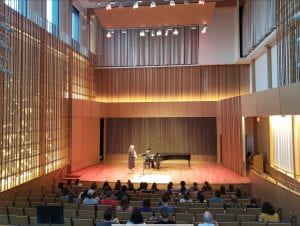An icon of the style, architecture and furnishings of mid-century American collegiate buildings, the musical sounds emanating from Hughes Hall arrived at their double bar line just shy of the building celebrating its 75th year as the nurturing home of the School of Music at The Ohio State University. Hughes could be described as a somewhat stubborn building, maybe even a bit of a curmudgeon. Through all of its days, Hughes held fast to its checkered tiled floors, yellowed walls, worn wooden desks and stuffy practice rooms. It was only in its last few decades that Hughes finally did adopt one slightly modern comfort — window air-conditioners.
But just as brilliant music is more than simply vibrating air molecules, the Hughes era of the School of Music is much more than its extra-vintage building. As we move the last of our musical instruments from Hughes Hall to the new Timashev Family Music Building, please allow me to celebrate a few of the many historical figures of the Hughes era.

1949, Jack Fullen, President Bevis, Royal Hughes and looking over plans for Hughes Hall
Royal Delaney Hughes was among the first appointed music faculty members at Ohio State in 1921, and in 1925 was appointed the first chairman of the Department of Music, a position he held until 1938. Hughes, a beloved music teacher, hired several key faculty members including Eugene J. Weigel.
Eugene Weigel, the director of the Ohio State Marching Band from 1929–1939, was first to create the “Script Ohio” performed in Ohio Stadium in 1936. Weigel was a violinist, an orchestral conductor and a marching band director. He became chairperson of the Department of Music after Hughes’ death in 1938. Weigel was instrumental in the advocating for the groundbreaking of a new music building in Hughes’ honor.

Weigel’s original design of Script Ohio
A subsequent star in the school’s early history is Donald E. McGinnis who began a 40-year career at Ohio State in 1941. Under his baton, the Ohio State Concert Band earned a national and international reputation, having taken the ensemble to Carnegie Hall and Lincoln Center. With the Columbus Symphony he performed principal clarinet for two years, and principal flute for ten.
In 1953, Jack O. Evans directed the Marching Band, taking it to new heights and overseeing the naming of the then “Buckeye Band.” The band included students from across the university, and appeared in both formal and twilight concerts.
Composer Donald Harris taught music at Ohio State for 22 years, serving as Dean of the College of the Arts from 1988 to 1997. He was a close collaborator with Gunther Schuller and won numerous awards as both a composer and an administrator. He established funding from the Getty Foundation to support the Ohio State Contemporary Music Festival. Harris was an inspiring mentor to decades of students.
Burdette Green, a musical polymath, dedicated 54 years of service as a faculty member to the School of Music. His cross-discipline expertise includes saxophone, clarinet, jazz, musical acoustics, and history of music theory.
Music composition and theory professor Gertrude Kuehefuhs had the nuanced balance of high expectations with immense compassion. She was a legend of music theory, and as a pianist she collaborated significantly with faculty, particularly known for her ability to “sight-read anything.”
Irma Cooper taught voice and opera for 20 years at Ohio State. She co-founded Opera Columbus, and was a champion of teaching young singers. She created multiple awards, funds and scholarships to support them. She was involved with the American Institute of Musical Studies in Graz, Austria.
James B. Jones was a celebrated horn professor who was highly active as a chamber and orchestral musician. He played in several ensembles including The Ohio State University Brass Quintet, The Ohio State University Woodwind Quintet, the Columbus Symphony, was principal horn with the Toledo Symphony, and toured and recorded with the Cleveland Orchestra.
Born on a farm in Ohio, Mary Ruth Tolbert was an alumna of Ohio State. She taught music education at Ohio State for over 40 years, and was well-known for her book This is Music, an elementary music textbook series used across the country. She was “ahead of her time” in social and educational issues. She was multi-faceted as an educator, a musician, intellectual, a farmer and an Ohio historian.
It’s both fascinating and humbling to look back at the path the School of Music has taken. Just as we view the many stars in the night sky, we look back to the incredible figures — so many faculty and staff — who have inspired generations of student musicians.
THE HUGHES HALL LEGACY PROJECT
Last spring, we invited our alumni and faculty to reflect on their time in this iconic building. As you read through these heartwarming and entertaining Hughes Hall memories, you will detect the emerging theme — it is not a building, but the relationships that inspire creativity and success. That is the legacy of Hughes Hall.

